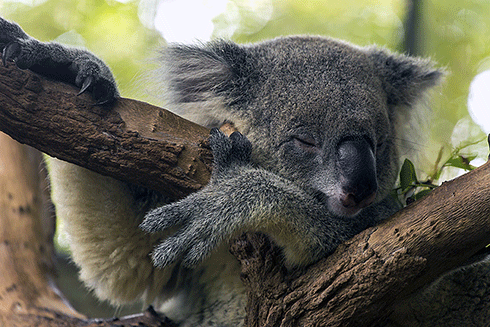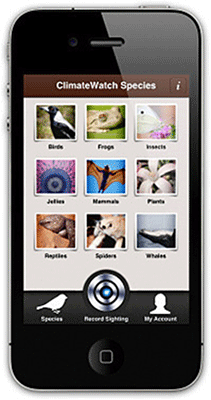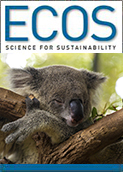
|
Published: 21 July 2014
Citizen science and mobile technologies evolve together
Mobile tech gives citizen scientists the edge in data collection for small budget, big scope projects

|
|
Koalas are widespread and patchily distributed over the landscape – this makes spotting them a perfect job for citizen scientists. Credit:
Thinkstock
|
Last year, 273 people living on the east coast of Australia walked through their local bushland looking for koalas. Smart phones in hand, they answered questions asked by an app about the vegetation and land use. If they saw a koala, the phone’s built-in GPS receiver recorded its location as they took a picture. With a press of a button the data they collected was sent back to researchers.
These koala spotters were citizen scientists – volunteers collecting data as part of a greater scientific enquiry.
Dr Chris Gillies, Director of Science at Earthwatch Institute, an NGO engaging people in scientific field research and education, explains that the vast majority of the species sightings recorded are submitted through mobile devices. According to Dr Gillies, mobile devices have revolutionised the way data is collected, making on-the-spot observations quicker and easier, and reducing error rates when submitting data and logging locations.
In Dr Gillies’s view, designing data collection apps is only one of the aspects of developing citizen science. You still need good science and communication to engage volunteers.
‘Citizen science is an exchange. Scientists get data and more hands on deck. Citizen scientists gain new understandings and meet new people, including scientists,’ says Dr Gillies.
Citizen science is as much a philosophy of collaboration as it is a method of science. Finding ways to feed the results back to the community is an important part of the collaboration. Benefits include greater community support and understanding of research and science.
In the last five years, there has been an explosion of citizen science projects internationally and Australia is beginning to follow suit. According to the Citizen Science Network of Australia, there are over 100 citizen science projects in Australia. They cover research areas within medicine, astronomy and the environment.
A range of factors underpin the growing popularity of citizen science. Budget pressures are forcing researchers to rethink the ways in which they collect large amounts of data. Technology improvements are helping scientists work with the community to produce credible, verifiable data for research projects. Citizen science projects also help educators engage audiences and are an avenue for communicators to share science with communities.
Atlas of Living Australia
The Atlas of Living Australia (Atlas) is Australia’s largest collection of biodiversity information. The free and open access information it holds is sourced from museums, herbaria, community groups, government departments, individuals and universities. The Atlas is a partnership between CSIRO, Australia’s museums and herbaria, biological collections, research organisations, universities and government departments, and is built on open source data and infrastructure. In February 2014, The Atlas of Living Australia reached a major milestone, clocking up one billion downloads.
An associated app called OzAtlas allows anyone to upload sightings into the Atlas, explore what’s in their area and search for information about particular species.
Many of the sightings recorded in other citizen science projects are also fed into the Atlas of Living Australia, such as koala counts, and ClimateWatch.
Engaging communities in koala research
Koala research is particularly suited to citizen science projects as koalas are widespread and patchily distributed over the landscape. They also are found on both crown and private land and are difficult to spot.
Dr Andrew Baker is a research scientist with CSIRO Land & Water. Dr Baker was involved in developing an app for the South Australia Great Koala Count in 2012. Using the app, citizen scientists participating in the project took geotagged photos of koalas in the field with their phones, and sent them in to researchers on the project.
After accounting for biases such as the high proportion of sightings being close to roads, the researchers have used the findings to predict koala distribution in South Australia.
For this project, app and website design was as important as experimental design. The app needed to be simple, intuitive, and enjoyable to use.
Dr Baker believes technology such as this is a great way to engage a community and get people on-side with research. The koala count app was developed through a collaboration between the Atlas of Living Australia and CSIRO as a side project, an offshoot of the passion of researchers and other staff, indicating the level of enthusiasm for citizen science projects among the scientific community.
Another koala count, held by the National Parks Association of NSW with the support of the Atlas of Living Australia, also produced a smart phone app for citizen scientists. The area surveyed included the east coast of Australia from Victoria up through New South Wales and into Queensland.
The budget on this project was tight, so social media, local media, workshops and local conservation groups were used to recruit the citizen scientists. In the end, 273 people volunteered over the ten day period and they spotted 1000 koalas. There is a plan to do the count again next year, collecting valuable data on the distribution of koalas over the landscape.
Keeping an eye on changing habitats
ClimateWatch is a citizen science project that records the seasonal life cycles of plants and animals and tracks changes in these patterns. Changes might include seasonal changes such as early flowering dates and changed species distribution.
Dr Linden Ashcroft from ClimateWatch says people spend so much time on their phone that using a smart phone app is a good way to get them outside and observing.
‘Many people have said that using the ClimateWatch app improved their understanding of the world around them – once you spend some time looking for a species, you never look at it the same way again,’ says Dr Ashcroft.
Before ClimateWatch released their app in mid 2012, there were 3000 people participating in their citizen science program. Now there are 13 000.
‘I think using a smartphone app improves data quality because it provides GPS locations, whereas before this had to be done by hand. The second bonus is that it makes it really easy for people to take a picture, which makes it much easier for a scientist to verify the species,’ says Dr Ashcroft.
‘It’s particularly valuable for plants. We monitor about 40 different plant species and it’s easier to take an image of a plant rather than a bird or a butterfly.’
Dr Ashcroft explains that while the pictures are often not perfect, they still give researchers a great opportunity to look at a species. So far 60 000 observations have been submitted through the ClimateWatch program, most of which are available on the Atlas of Living Australia website.
Now that the app has been in use for a couple years, ClimateWatch can see ways it could be improved to enhance the quality of data collected. For example, an inbuilt quality check could give a query message every time a user claimed to see a species outside its normal distribution.

|
|
ClimateWatch’s app helps users track changes in the seasonal life cycles of plants and animals. Credit:
Earthwatch Australia.
|
Game on for biodiversity
Games on smart phones and tablets are another way to harness people’s enthusiasm for observing the natural world. In the bird-spotting game Questabird, players complete observational challenges. Questabird begins by getting players to find the common birds in their area and rewarding them with points when they do. Players can then progress to the next level to spot rarer birds.
Citizen Science Network of Australia
The Citizen Science Network of Australia had its inaugural meeting in May this year. With 90 people in attendance, the meeting established working groups with the aim of making the network a reality.
Interested parties came from museums, universities, local councils, specific research projects and included citizen scientists themselves. It is hoped that this network will further citizen science research in the future, providing resources, information and networking opportunities.



